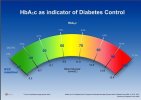Jan1956
Active Member
- Relationship to Diabetes
- Type 2
- Pronouns
- She/Her
So, reading that a Hba1c of say 48 mmol/mol is equivalent to 6.5 % ?
In my case my Hba1c of 55 is therefore 7.2%
My question is when I’m taking my finger prick tests the results are recorded as mmol/L
So, when I get my average readings on a contour plus monitor of say 8.2 mmol/L I’m
wondering if this the same as having 8.2 % on a Hba1c test?
If so my Hba1c average is likely increasing?
However,
On The Libre 2 seems to calculate an average Hba1c
Is there a a calculation formula I could use with my average finger prick results ( mol/l ) to give me an indication of my future HBa1c reading?
Thank you
In my case my Hba1c of 55 is therefore 7.2%
My question is when I’m taking my finger prick tests the results are recorded as mmol/L
So, when I get my average readings on a contour plus monitor of say 8.2 mmol/L I’m
wondering if this the same as having 8.2 % on a Hba1c test?
If so my Hba1c average is likely increasing?
However,
On The Libre 2 seems to calculate an average Hba1c
Is there a a calculation formula I could use with my average finger prick results ( mol/l ) to give me an indication of my future HBa1c reading?
Thank you

